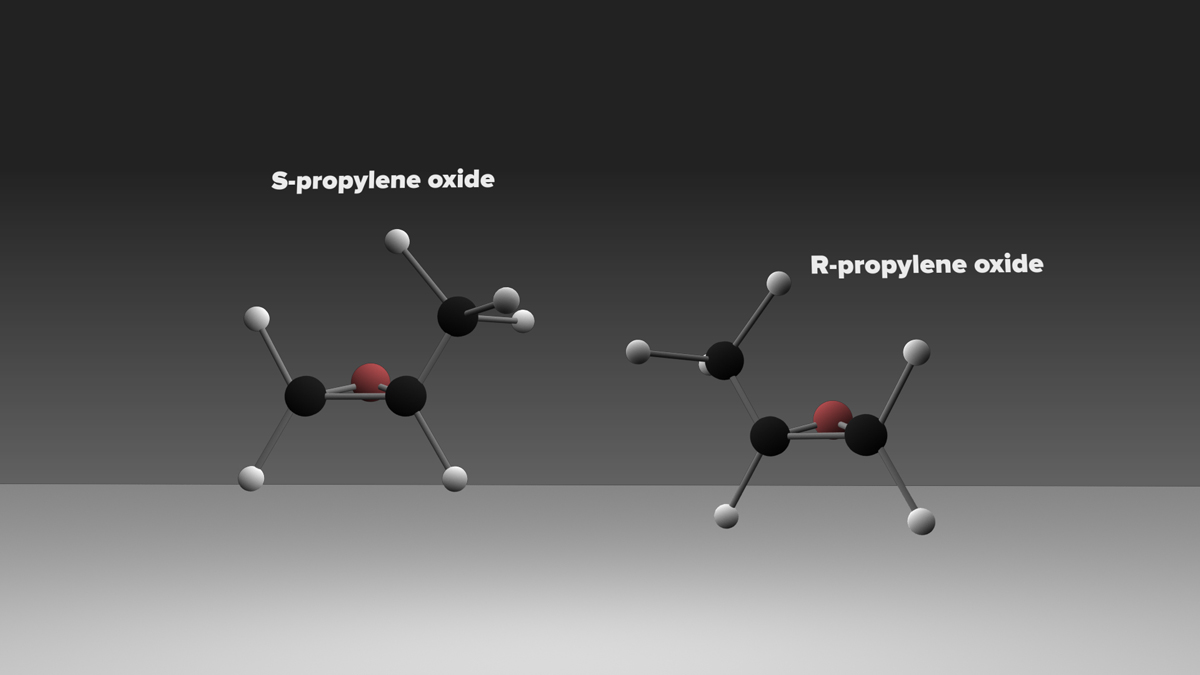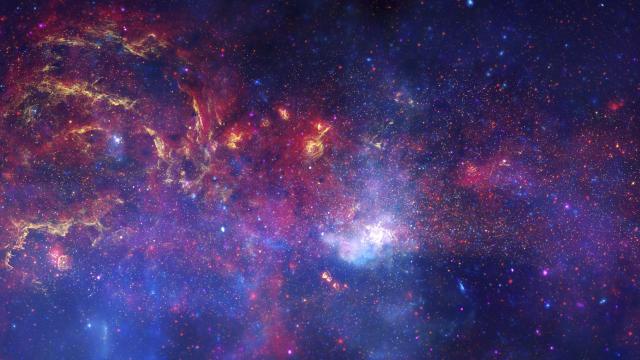Using some of the world’s most sophisticated telescopes, a pair of astronomers has discovered a first-of-its-kind organic molecule in an enormous star-forming cloud thousands of light years away. And it could shed light on one of most poorly-understood properties of life on Earth.
Composite view of the centre of our galaxy. Image: NASA/JPL-Caltech/ESA/CXC/STScI
The molecule, propylene oxide (CH3CHOCH2), is chiral, meaning it can form “left-handed” and “right-handed” versions that are perfectly symmetric and have identical physical properties. Chiral molecules will be familiar to anybody who’s taken a biology course — they form the backbone of DNA and the building blocks of proteins. But oddly enough, the chiral molecules underpinning our biology are either left- or right-handed, never both.
How this pattern of single-handedness, or “homochirality”, emerged on Earth is a mystery. Now, the first discovery of chiral molecules beyond our solar system could lead to answers.
“Chirality is really important for biology,” said Brandon Carroll, one of the two lead authors on the study published today in Science. “All amino acids [on Earth] are left-handed, and it lets them build really big and interesting proteins. DNA’s double helix structure is based entirely on the fact that it uses right-handed sugars for the backbone.”

The two “hands” of propylene oxide, the first chiral molecule ever discovered beyond our solar system. Image: B. Saxton/NRAO/AUI/NSF
While the biological advantages of homochirality are obvious, what’s less clear is how this unique property of life emerged and why certain molecules exist in the left- or right-handed version. Given that the building blocks of life — simple chains of carbon, hydrogen and oxygen — probably came from outer space, studying patterns of chirality beyond Earth offers a tool for peering into our distant past.
To date, astrobiologists have found chiral molecules buried in meteorites on Earth and in samples collected on the surface of comets. “The link between chiral molecules in space and life on Earth is the evidence we see in meteorites, where there’s a slight excess in [left-]handed amino acids,” Carroll said. “If you want to understand where that excess comes from, studying interstellar clouds is the earlier link.”
Which is exactly what Carroll, and his co-author Brett McGuire, have spent the last the last few years doing. They have focused their research on Sagittarius B2, a cloud of interstellar dust that weighs as much as 250,000 suns and is situated some 28,000 light years away toward the centre of our galaxy. SagB2 is something of a Holy Grail for astrobiology — the vast majority of the molecules ever discovered in space have been spotted in its swirling, radiation-bombarded dust. “It’s just the best place to find molecules,” McGuire told Gizmodo.
Piggybacking on years worth of radio emissions data on SagB2 collected by the National Radio Astronomy Observatory, Carroll and McGuire recently began a search for propylene oxide, one of the smallest and simplest chiral molecules. After identifying some promising spectral features in the dataset, they independently confirmed the presence of propylene oxide using the Parks Radio Observatory in Australia.
“If you add up all of the propylene oxide we found, it weighs about four fifths of an Earth,” Carroll said, adding that while this sounds like a lot, it pales in comparison to the size of the SagB2 cloud, and is just at the limit of our detection threshold. Larger, more complex chiral molecules are expected to be even rarer, and will prove more difficult to spot.
But we may not have to find other chiral molecules in interstellar space to glean important insights into the origins of homochirality on Earth. “Even if we can’t detect other chiral molecules, if we can measure an excess of handedness in propylene oxide, that will be useful for understanding the processes driving chiral molecules in one direction or another,” Carroll said.
It may be that because of how organic molecules form in interstellar clouds, any life that emerges anywhere in our galaxy is always going to be biased toward certain patterns of chirality. Perhaps left-handed proteins and right-handed genetic code are fundamental traits of life everywhere. Maybe the patterns that emerged on Earth are influenced by more local processes. Or maybe they’re just random.
To start distinguishing these possibilities, McGuire and Carroll are now trying to determine the chirality of the propylene oxide they have observed. “The technology exists, but the observations are time intensive and take a lot of effort,” McGuire said, explaining that chemists use polarised light to determine the chirality of organic molecules in the lab all the time. “Nobody has ever tried to do this in astronomy.”
But it’s a worthy challenge, not just because of what it could reveal about our past, but because of its implications for humanity’s future. If and when we discover life on other worlds, will it be built according to a similar or different blueprint? Will it be “compatible” with our biology?
These are the sorts of question science fiction authors have been playing with for years, and the answers could have real consequences for our ability to survive on other planets. As Carroll put it, “If you ate a cheeseburger on a world that was a different chirality, I don’t know if it would be poisonous, or you just wouldn’t digest it — but it wouldn’t be compatible at all.”
“Homochirality is a very useful tool, and it’s not unreasonable to expect life to exploit it elsewhere,” McGuire said. “By studying these astrophysical processes, we may eventually be able to look at a star and say whether life on the planets around it should be this or that handed.”
And hey — any research that will help humans determine whether a planetary system is fit for colonisation or a wasteland of indigestible lunch meats sounds like a solid investment in our future.
